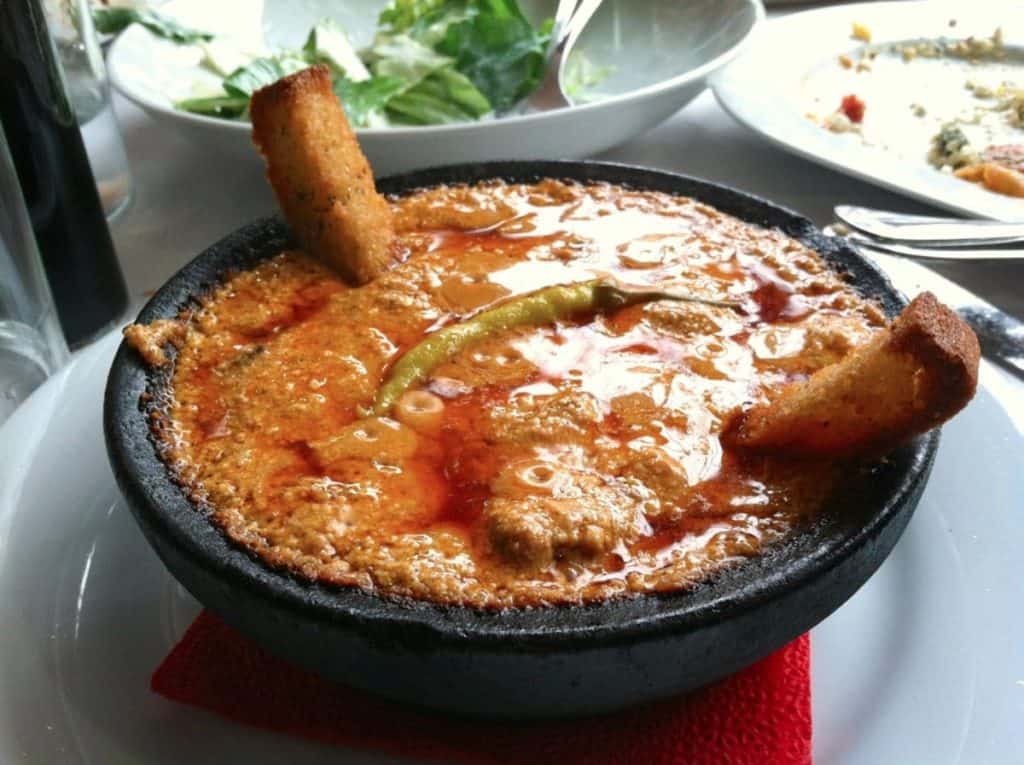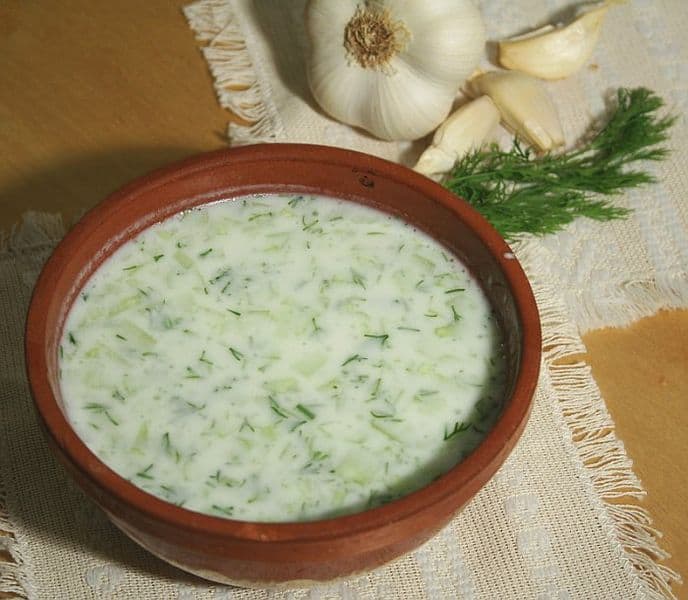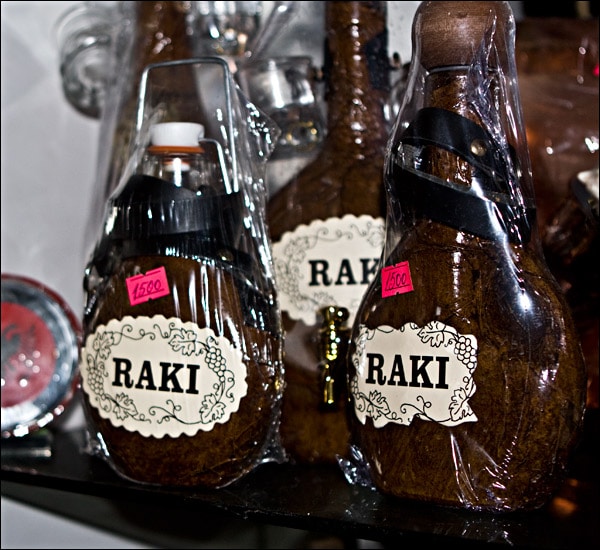The dishes of Albania have their roots with the ancient Ottoman Empire. The combination of richly fertile land, proximity to the sea, and blurry cultural lines with their neighbours have culminated in a modern cuisine that is both diverse and simple. Modern day influences include Greece, Italy, and Turkey.
Meat and vegetables are the staple, along with heavy stews, pickled cabbage, feta cheese, breads, rice, and smoked meat. The most popular veg grown are eggplants, peppers, tomatoes, cucumbers, olives (which accompany most meals), and legumes. Very Mediterranean indeed! Vegetarians be warned. There are a lot of salads in your future – luckily, there’s plenty of fresh produce to enjoy.
Regional Differences
When talking about food, travellers can divide the country into three regions. In the north, the staple is ground corn. Not only is it used for most breads, it’s also versatile enough to make both sweet and salty dishes. The climate is good there which means there is a variety of fresh vegetables and fruit. You’ll see mostly potatoes, carrots, cabbage, kidney beans, onions, garlic, and walnuts. Traditional dishes in the north include meat and vegetable casseroles, pasta, chicken, rice, sudjuk (similar to salami), and petula (fried dough made sweet or savoury). If you visit Shkoder, you’ll be able to enjoy carp and acne dishes thanks to the many lakes and rivers nearby.
Central Albania has the kind of soil that can grow just about anything. Poultry features heavily in dishes here – duck, goose, chicken, and turkey are all raised here. Fishermen catch flounder, perch, gray mullet, and sole in the Adriatic Sea. You’ll find egg, spinach, or cabbage cakes, nettle cakes, liver, and curd. Tav elbasani is a highlight you won’t want to miss. It’s made by baking meat in yogurt.
Most of the cattle are raised in the southern region of Albania, which means that dairy products often take centre stage in dishes. It’s well known for fantastic hard and soft cheeses, as well as kefir so thick that you could cut it with a knife. The climate is warmer here and so you’ll find citrus and olive groves throughout the area.
Other regions worth noting are the Berat region where you’ll find the Balkans largest fig plantations. The fig jam and dried figs always make popular gifts. Myzeqe produces turkey and Albanians say the turkey and mash (a kind of stew) is the best here. And along the Albanian Riviera you’ll find fantastic seafood options year round. Whatever you’re in the mood for, you can be certain it was caught fresh that morning.
It’s worth noting that most of Albania is mountainous – about 70% in fact. Those villages located in the higher elevations make use of animal organs. In many places, intestines and the head are considered delicacies.
Meat Dishes
 Source: recetagatimingalida
Source: recetagatimingalidaMeat dishes are by far the most ubiquitous meal you’ll find in Albania. The most popular are veal stew (ferges), roast beef in fermented milk sauce (rosto-misalche-kosi), cabbage rolls (sarma), and sheep pluck stuffed with meat and vegetables (kukurech). Almost all meat dishes are served with bread and/or rice, as well as some greens.
Soup
 Source: wikipedia
Source: wikipediaDuring the summers a cold soup called tarator is served. It’s made with vinegar, cucumber, garlic, walnut, fennel, and spices. During the winters the Albanians have plenty of hearty stews to choose from. Try sataras, a lighter stew made with tomatoes, onions, and paprika. There’s also your standard meat and onions stew (chumlek) and meat with potatoes (guvech).
Pies
 Source: discoveringalbania
Source: discoveringalbaniaSavoury dinner pies are a favourite in Albania. And they are just as hearty as their stews and just as flavourful. Try byrek, made with feta cheese cabbage, spinach, tomatoes, and meat all layered in a tasty filo pastry. Kungullur is filo pastry and pumpkin, butter, salt, or sugar. And finally Kakllaasarem – a traditional food from Kosovo, it’s a layered pita without anything inside and covered with garlic and yogurt, served warm. It’s a typical lunch for the Albanians.
Sweets and desserts
 Source: albanianews
Source: albanianewsAlbanians definitely have a sweet tooth and you’ll find that most enjoy a dessert with their meals. There are lots of fruit and cream dishes, as well as cookies and baklava. When you’re looking for something to top off your meal, look for wheat (ashure) or rice (sultash) puddings, fried dough in a rich syrup (tollumba), or crystallized fruit (oshaf). Boza, a fermented malt drink, often accompanies dessert.
When you’re just looking to satisfy a sweet craving, do as the Albanians do and have halva. It’s flour or semolina, with lots of sugar, cooked to make one of the most popular sweets in the country. Other equally popular options are variations of sweet or savoury dough balls.
But the most surprising desserts are those made of simple fresh fruit. Fruit is enjoyed all year in Albania – eat them fresh or find them made into jams and compots. Albanian cherries are well known – as are pears, peaches, and apples.
Drinks
 Source: trekearth
Source: trekearthAlbania isn’t known for their wines, which is a bit of a shame. They’ve got an excellent bouquet and taste. The upside is that, because the international market hasn’t caught on yet, they are also low cost. Look for reds like Shesh and Zi, made in Durres and Tirana, Mavrod from Leskovik, and Calmet from Shkoder and Peshop. For whites, look for Riesling from Durres, and Shesh I Bardhe from Tirana. Local beer brands include Kaon, Norga, Stela and Tirana. Skandenberg, a high quality cognac, is also made in Albania.
The national drink is, without doubt, grape brandy, or Raki. Often home brewed, often powerful, you won’t make it far without being offered a taste of national pride. For non-alcoholic drinks, Albanians prefer Turkish espresso and coffee. You’ll find it to be much stronger there than the rest of Europe. The Balkan presentation is called kafe turke and is made by brewing the ground and sugar together.
National Specialities
 Source: arousingappetites
Source: arousingappetitesThe national dish is baked lamb, rice, and yoghurt sauce called tavë kosi. Everybody’s mother makes it best! Other specialities include pace, which is made by boiling an animal head (usually pig, cow, or sheep) until the meat comes off. It’s then made into a stew with onion, garlic, and other spices. You might also try harapash, a polenta based dish cooked with lamb intestines, butter, cheese, and corn flour.
Dinner appetizers or platters are usually served with salami, prosciutto, feta cheese, green olives, and roasted red peppers. To follow, try koran, a species of trout unique to Albania, jufka, handmade pasta, oofte ferguara, fried lamb or beef meatballs served with feta cheese and bread, or flifa, a humongous pancake, more like a pie, made by layering crepe and served with melted cream cheese.
